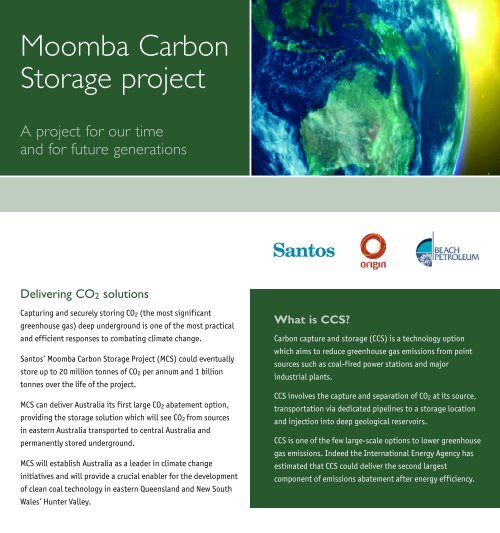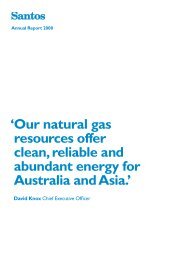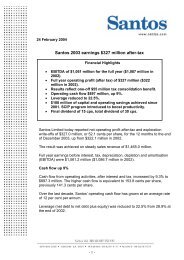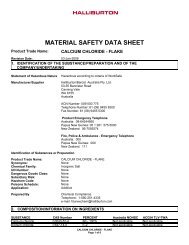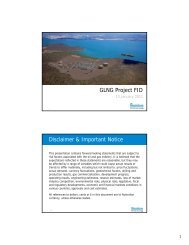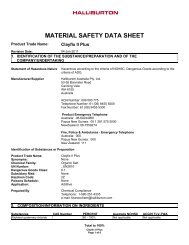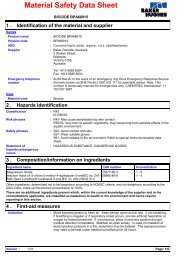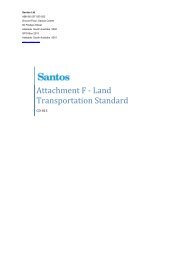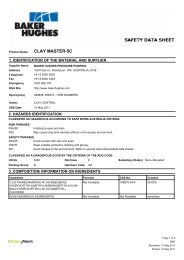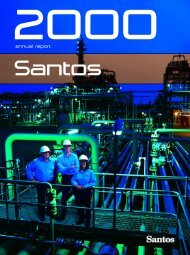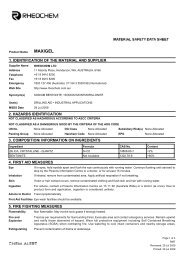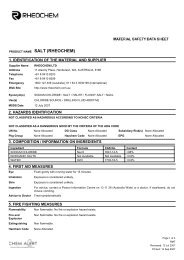Moomba Carbon Storage project - Santos
Moomba Carbon Storage project - Santos
Moomba Carbon Storage project - Santos
- No tags were found...
Create successful ePaper yourself
Turn your PDF publications into a flip-book with our unique Google optimized e-Paper software.
<strong>Moomba</strong> <strong>Carbon</strong><strong>Storage</strong> <strong>project</strong>A <strong>project</strong> for our timeand for future generations<strong>Santos</strong>Delivering CO2 solutionsCapturing and securely storing CO 2 (the most significantgreenhouse gas) deep underground is one of the most practicaland efficient responses to combating climate change.<strong>Santos</strong>’ <strong>Moomba</strong> <strong>Carbon</strong> <strong>Storage</strong> Project (MCS) could eventuallystore up to 20 million tonnes of CO 2 per annum and 1 billiontonnes over the life of the <strong>project</strong>.MCS can deliver Australia its first large CO 2 abatement option,providing the storage solution which will see CO 2 from sourcesin eastern Australia transported to central Australia andpermanently stored underground.MCS will establish Australia as a leader in climate changeinitiatives and will provide a crucial enabler for the developmentof clean coal technology in eastern Queensland and New SouthWales’ Hunter Valley.What is CCS?<strong>Carbon</strong> capture and storage (CCS) is a technology optionwhich aims to reduce greenhouse gas emissions from pointsources such as coal-fired power stations and majorindustrial plants.CCS involves the capture and separation of CO 2 at its source,transportation via dedicated pipelines to a storage locationand injection into deep geological reservoirs.CCS is one of the few large-scale options to lower greenhousegas emissions. Indeed the International Energy Agency hasestimated that CCS could deliver the second largestcomponent of emissions abatement after energy efficiency.
The <strong>project</strong><strong>Moomba</strong> <strong>Carbon</strong> <strong>Storage</strong> involves three main phases, ultimatelydelivering a regional carbon storage hub for eastern Australia.Phase 1, will demonstrate the technical and economic feasibilityof storing CO 2 in depleted oil and gas fields in the Cooper Basin,in central Australia. It involves the capture of all CO 2 separatedas part of the gas processing operations at <strong>Moomba</strong>,transporting that CO 2 to a designated site and injecting the CO 2stream into partially depleted oil reservoirs.The injected CO 2 will re-pressurise the reservoirs and sweepresidual oil left behind by traditional recovery methods (this iscalled enhanced oil recovery). Over time the oil is graduallyexhausted, at which point the extraction wells are capped.Injection continues and the CO 2 is permanently stored andmonitored in the underground reservoir.This phase, which could commence as early as 2010, will captureand permanently store 1 million tonnes of CO 2 each year.The second phase focuses on building capacity and confidencein the technology as increasing volumes of CO 2 are movedtowards <strong>Moomba</strong>. MCS would link to the development of a cleancoal power generation <strong>project</strong> in eastern Queensland or/andNew South Wales’ Hunter Valley. CO 2 captured from that <strong>project</strong>would be transported towards <strong>Moomba</strong> utilising existinginfrastructure wherever possible.Assuming success in the first two phases, carbon capture andstorage will become commercial reality in the final phase of the<strong>project</strong>. Phase 3 will deliver Australia’s first common-usercarbon storage hub at <strong>Moomba</strong>. Significant quantities of CO 2would be captured from key point sources in New South Wales,Queensland and South Australia. Dedicated CO 2 pipelines wouldbe built to connect these emitters to the <strong>Moomba</strong> carbonstorage hub. The CO 2 would be distributed to designated sitesand stored in depleted oil and gas reservoirs or deep aquifers.<strong>Moomba</strong> processing facility, central Australia.
Oil fieldGas fieldOil pipelineGas pipelineMapped Area<strong>Storage</strong> of CO2 in the Cooper Basin1. Once the CO 2 has been captured from the source it will becompressed to reduce it to a super-critical liquid ready fortransportation.2. The “liquid” CO 2 is then injected at high pressure into thesubterranean reservoir thousands of metres underground.3. An impenetrable rockcap will hold the CO 2 in place.Cooper Basin oil and gas fields and pipline infrastructureWhy the Cooper Basin and <strong>Moomba</strong>?<strong>Moomba</strong> <strong>Carbon</strong> <strong>Storage</strong> (MCS) represents a unique andcompelling opportunity to implement an early (2010),full-cycle (capture to storage), commercial-scale (> 1 milliontonnes per annum) carbon capture and storage <strong>project</strong> inAustralia.1. The Cooper Basin oil and gas fields, coupled with the<strong>Moomba</strong> processing plant, are Australia’s largest onshoreresource <strong>project</strong> representing $8billion of investment.The Cooper Basin geology is very well-understood, withover 2300 wells, 220 fields and nearly 40 years ofproduction history.2. Initial storage will be in depleted oil and gas fields withsubsequent scale-up into saline aquifers.3. MCS is ready-to-go. All components are in one place underaligned commercial ownership.4. The Cooper Basin and <strong>Moomba</strong> are centrally located withrespect to major existing pipeline corridors in Qld, NSWand SA, yet remote from major population centres.4. The injection wells are capped and over centuries the CO 2will combine with water to form harmless minerals.123300 metreimpenetrablerockcap45. Legislation exists in SA to allow this <strong>project</strong> to commencenow.6. The <strong>Moomba</strong> <strong>Carbon</strong> <strong>Storage</strong> <strong>project</strong> will store up to20 million tonnes of CO 2 per annum for up to 50 years.Underground CO 2 storage solution more than 2.5 kilometres below the surface.
Managing any risksThe risk of CO 2 leakage from the depleted Cooper Basin oil andgas reservoirs is extremely low. These reservoirs have trappedhydrocarbons for millions of years and are expected tosimilarly entrap CO 2. In addition, any potential for leakagewill be managed through careful storage and site designbacked up with rigorous early detection mechanisms. TheCooper Basin has been recognised by Geoscience Australiaand others as an ideal geosequestration site because of thehighly impermeable caprocks, geological stability, absence ofleakage paths and trapping mechanisms.In terms of surface facilities, <strong>Santos</strong> has been safelyproducing, processing and transporting gas in the CooperBasin for nearly 40 years. In addition, <strong>Santos</strong> has beenroutinely injecting and withdrawing gas from a majorunderground gas storage facility at <strong>Moomba</strong> for over 15 years.Mtpa = million tonnes per annumWho’s involved?The <strong>Moomba</strong> <strong>Carbon</strong> <strong>Storage</strong> <strong>project</strong> is being developed by<strong>Santos</strong> as the operator of the Cooper Basin Joint Venture. Theother parties involved are Beach Petroleum and Origin Energy.This team has decades of oil and gas exploration and productionexperience coupled with a proven track record in major <strong>project</strong>management.<strong>Santos</strong> is a leading Australian energy company with theexperience, knowledge and vision to deliver Australia’s firstcommercial-scale CO 2 storage <strong>project</strong> at the <strong>Moomba</strong> gas hub.<strong>Santos</strong> has sought a Commonwealth government grant tosupport the development of the demonstration phase of MCS.“At <strong>Santos</strong> we recognize one of our key environmentalresponsibilities is to pursue strategies that addressthe issue of greenhouse gas emissions.”<strong>Santos</strong> Greenhouse Policy, 2004.<strong>Moomba</strong> storagepotential1000MtSouth Australia14MtpaQueensland65MtpaNew South Wales76MtpaFor further information contact:General enquiriesMedia enquiriesMike CongreveMatthew Doman<strong>Santos</strong> Limited<strong>Santos</strong> Limited60 Flinders Street, Adelaide 60 Flinders Street, AdelaideSouth AustraliaSouth Australia+61 (8) 8116 7613 +61 (8) 8116 5260500 kmVictoria83MtpaStationary energy emissions sources<strong>Carbon</strong> infrastructure develops around existing gas infrastructure<strong>Santos</strong>


